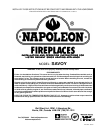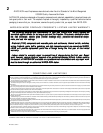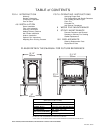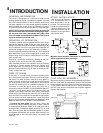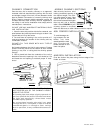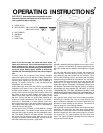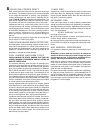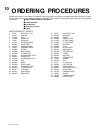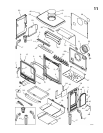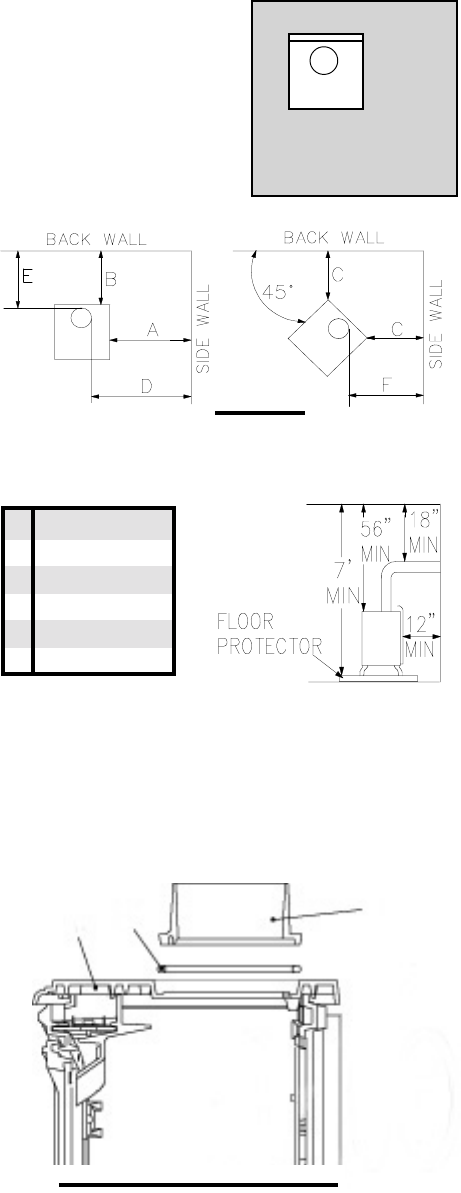
4
W415-0257 / 08.02.01
INTRODUCTION
GENERAL INFORMATION
The Savoy is designated as a continuous wood burning
heating appliance having a combustion chamber enclosed
with cast brick walls where all fuel is meant to be burnt on
the grate supplied. It is a top vented appliance capable of
being installed near a wall. It has an adjustable air control
for controlling the burning rate as well as a large ash-pan.
NOTE: The following items supplied with the unit must
be removed from the firebox before attempting to oper-
ate the stove: flue collar, door handle tool, poker, oven
mitt, ash fender and installation hardware. The stove is
not to be connected as a rear vent.
PRINCIPAL OF OPERATION
The Savoy is designed to be operated with the door closed.
Without the optional blower, EP62, the heat produced is
mainly transmitted through the window and the body of the
unit. Combustion occurs on the grate with combustion air
introduced through the top of the combustion chamber.
Be sure to provide sufficient combustion air. There are many
other appliances in your home competing for air such as: a
kitchen range hood, forced air heating devices or a bath-
room exhaust fan.
Expansion / contraction noises during heating up and cool-
ing down cycles are normal and to be expected.
After extended periods of non-operation such as following
a vacation or a warm weather season, the fireplace may
emit a slight odour for a few hours. This is caused by dust
particles on the firebox burning off. Open a window to suffi-
ciently ventilate the room.
CARE OF GLASS
If the glass is not kept clean permanent discolouration
and / or blemishes may result. Normally a hot fire will clean
the glass. The most common reasons for dirty glass in-
clude: not using sufficient fuel to get the stove thoroughly
hot, using green or wet wood, closing the air control so far
that there is insufficient air for complete combustion. If it is
necessary to clean the glass, use a soft cloth with a
nonabrasive cleaner. DO NOT CLEAN GLASS WHEN HOT!
The glass is very strong but do not let burning fuel rest
against it and always close the door gently. If the glass
should ever crack while the fire is burning, do not open the
door until the fire is out and do not operate the stove again
until the glass has been replaced with a new 5mm thick
plate of ceramic glass, available from your Napoleon / Wolf
Steel Ltd. dealer. DO NOT SUBSTITUTE MATERIALS.
To remove the door glass, open the door; remove the
screws and brackets holding the glass in place. Remove
all broken glass. Wrap the edges of the new glass with a
U-shaped strip of fiberglass gasket, covering 1/4" on each
side. Place the glass with the fiberglass gasket in position
and replace the brackets and screws. When finished, you
should be able to move the glass slightly, horizontally and
vertically.
I NSTALLATION
STOVE INSTALLATION
If the stove is to be installed
on a combustible floor, it
must be placed on an ap-
proved non-combustible
hearth pad, that extends 8"
(200mm) beyond the left
stove side and back, and 18"
(455mm) to the right stove
side and the front.
Maintain these minimum clearances to combustibles
with a single wall chimney connector:
FLUE COLLAR ASSEMBLY
Before the chimney connector can be attached to the stove,
the flue collar must be assembled. Remove the top plate
by removing the two allen screws on either side of the stove.
Fit the ceramic rope into the groove on the top and secure
the flue collar with the three bolts and washers supplied.
Replace the top plate.
FIGURES 2
FIGURE 3 - CUT AWAY SIDE VIEW
FLUE COLLAR
CERAMIC
ROPE GASKET
TOP PLATE
A 20" (508mm)
B 12" (304mm)
C 14" (355mm)
D 28" (711mm)
E 16" (406mm)
F 22" (558mm)
18"
18"
8"
8"



